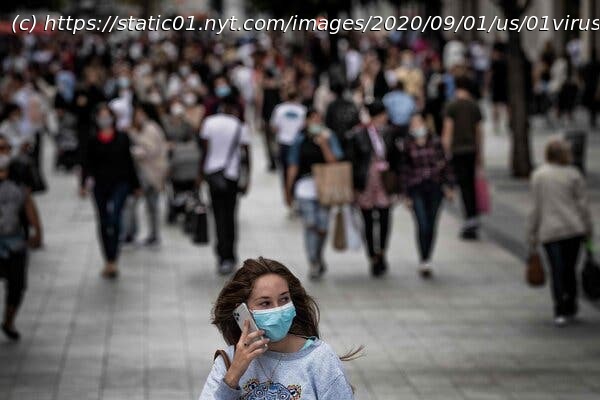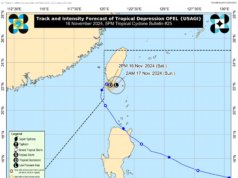From Wuhan to Paris and many places in between, students are back after months out of school. Children of color have been found to be more vulnerable to infection and to effects of the virus, new U.S. research finds.
Several state governments in the United States may soon send residents an alert to their smartphones asking them to turn on “exposure notifications.” Here’s why. On Tuesday, Apple and Google said they would make it easier for states to use their new technology, which detects phones that come close to one another and can notify people who may have been exposed to the coronavirus. States that sign on will be able to send a notice directly to iPhones and Android devices asking residents to opt in to the technology. Previous versions of the technology had required people to seek out a state health agency’s app. The new approach could mark a turning point in spurring the popularity of such virus alert technology in the United States. It significantly lowers the bar for states to adopt the technology, and makes it far easier for the public to enroll. Maryland, Virginia, Nevada and Washington D. C. already plan to use the new system, Apple and Google said, and about 25 other states were exploring using the earlier app version. In April, Apple and Google announced they were developing the technology, which uses Bluetooth signals to enable iPhones and Android devices to detect other nearby phones. If someone using the technology tests positive for the virus, they can enter the positive result into the system using a unique authentication code; an automatic notification would then go to other phones that had been in close contact. (The health agencies do not get any information on who actually went ahead and used the code on the app.) As the pandemic took hold this spring, countries around the world raced to deploy virus apps to help track and quarantine people. But many of the apps were mandatory and invasive, sending users locations and health details to their governments. Many apps were also rife with security flaws. The Apple-Google technology, by contrast, by contrast, does not ask users for personal health information or track their locations. To use their technology, state public-health authorities simply need to provide certain parameters to the companies, such as how close people need to be to trigger an exposure notification and recommendations for those with possible exposures. Google would then create an app for the state, while Apple would enable the technology on the iPhone software. The system relies on approximate location data to send an alert to residents’ phones in that state, asking if they would like to enroll. On iPhones, enrolling requires tapping a button, while Android users are prompted to download the state’s app. Still, some security researchers have warned that the technology could also be misused to send false alerts, spreading unnecessary alarm. While they acknowledged the companies’ desire to help stem the pandemic, a few said they were troubled by Apple and Google’s power to set global standards for public health agencies. People of color have been disproportionately affected by Covid-19, the illness caused by the coronavirus, and new U. S. research is heightening concern about the susceptibility of children in these communities. They are infected at higher rates than white children and hospitalized at rates five to eight times that of white children, the data shows. Children of color also make up an overwhelming majority of those who develop a life-threatening complication called multisystem inflammatory syndrome, or MIS-C. Of more than 180,000 Americans who have died of Covid-19, fewer than 100 are children, according to the Centers for Disease Control and Prevention. But children of color make up a majority of these children. The deaths include 41 Hispanic children,24 Black children,19 white children, three Asian-American children, three American Indian/Alaska Native children and two multiracial children. The unique vulnerabilities of these children are coming to light even as their number of infections is rising, and schools and parents around the country are grappling with nettlesome decisions about reopening safely. “Children don’t exist in a vacuum,” said Dr. Monika K. Goyal, a pediatric emergency medicine specialist at Children’s National Hospital in Washington. Among 1,000 children tested for the virus at a site in Washington in March and April, nearly half of the Hispanic children and nearly one-third of the Black children were positive, Dr. Goyal found in a recent study. They are more likely to live in homes where the parent or caregiver cannot telecommute, she said, so they are at increased risk of exposure. “They are also more likely to live in multigenerational households — it’s all connected,” Dr. Goyal said. Dr. Yvonne Maldonado, a professor of pediatrics at Stanford, agreed: “I know exactly what’s happening to those kids. Their parents are frontline, blue-collar or essential workers.” Researchers at Harvard have documented higher infection rates in Massachusetts communities with high proportions of immigrants, high numbers of food service workers and high numbers of people living in large, shared households. “What you have is the perfect recipe for fast transmission of Covid-19 in the Latino community,” said Jose Figueroa, assistant professor of health policy and management at the Harvard T. H. Chan School of Public Health. The true number of children who have been infected with the virus may not be known, as young children tend to have milder courses of the disease and have never been routinely tested in the United States. Gov. Ron DeSantis of Florida announced on Tuesday that he was directing state agencies to sever ties with Quest Diagnostics, effective immediately, for delays in providing the state’s health department with nearly 75,000 coronavirus test results that date back to April. According to state health officials, the delay did not drastically distort the extent of the pandemic in the state, which saw an overwhelming number of new virus cases over the summer. Without the data, the state on Monday reported a positivity rate of 5.9 percent. When including the missing Quest data, the positivity rate is 6.8 percent. The World Health Organization has said that — with comprehensive testing — the positivity rate should be less than 5 percent to indicate that a community has contained the spread of the virus. As of Tuesday, the number of daily tests being conducted in Florida is only 24 percent of the level considered necessary by the Harvard Global Health Institute to mitigate the spread of the virus, according to a New York Times analysis. Quest on Tuesday released a statement saying that the delay was the result of a “technical issue” and that it had been resolved. “We apologize for this matter and regret the challenge it poses for public health authorities in Florida,” the statement said. Adding, “Importantly, the issue did not affect or delay reporting of test results to providers and patients.” Dr. William Schaffner, an infectious disease expert at Vanderbilt University, took issue with the assurance from the state that such an oversight was limited to a data problem, and not something that could have shaped the spread of the disease.
Start
United States
USA — Science Covid-19 Live Updates: Apple and Google Offer Contact Tracing Right on Your...






